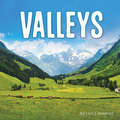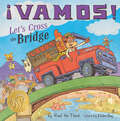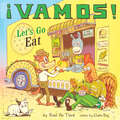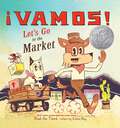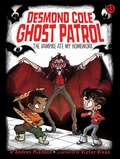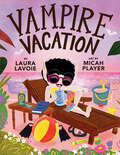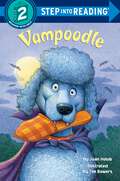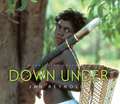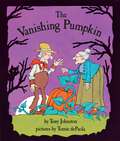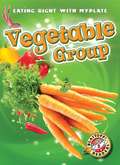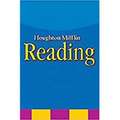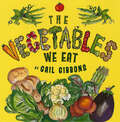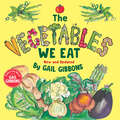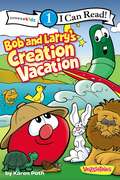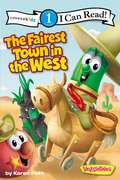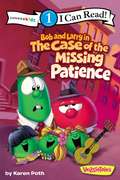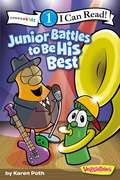- Table View
- List View
Valleys (Earth's Landforms)
by Lisa J. AmstutzAll valleys are long, low cuts in the earth, but there is more to these landforms than meets the eye! While rivers form most, glaciers and splits in the Earth's crust can form others. Some are at the bottom of the sea! Give beginning readers all the need-to-know information about valleys, including their characteristics, how they form, and where they can be found around the world.
Vamos a medir (¡Arriba la Lectura!, Leveled Reader Benchmark K-2, Level B #2)
by Elena Martin Doina ParaschivNIMAC-sourced textbook
¡Vamos! Let's Cross the Bridge (World of ¡Vamos!)
by Raúl the Third IIIWinner of the Pura Belpré Medal! A New York Times Best Illustrated Children's Book!Little Lobo and Bernabé return in ¡Vamos! Let’s Cross the Bridge, a joyful picture book follow-up to ¡Vamos! Let’s Go Eat about coming together and celebrating community from New York Times bestselling, three-time Pura Belpré Award–winning author-illustrator Raúl the Third.People are always crossing the bridge for work, to visit family, or for play. Some going this way; others going that way. Back and forth they go. With friends on foot and in bicycles, in cars and trucks, the bridge is an incredibly busy place with many different types of vehicles.Little Lobo and his dog Bernabé have a new truck and they are using it to carry party supplies over the bridge with their pals El Toro and La Oink Oink. The line is long and everyone on the bridge is stuck. How will they pass the time?
¡Vamos! Let's Go Eat (World of ¡Vamos!)
by Raúl the Third IIIWinner of the Pura Belpré Medal!Little Lobo returns to share his love of food and wrestling in ¡Vamos! Let’s Go Eat, a picture book follow-up to ¡Vamos! Let’s Go to the Market from New York Times bestselling, three-time Pura Belpré Award–winning author-illustrator Raúl the Third.Little Lobo is excited to take in a show with wrestling star El Toro in his bustling border town!After getting lunch orders from the luchador and his friends to help prepare for the event, Little Lobo takes readers on a tour of food trucks that sell his favorite foods, like quesadillas with red peppers and Mexican-Korean tacos.Peppered with easy-to-remember Spanish vocabulary and packed with fun details and things to see, this glorious celebration of food is sure to leave every reader hungry for lunch!
¡Vamos! Let's Go Read (World of ¡Vamos!)
by Raúl the Third IIIFrom New York Times bestselling, Pura Belpré Award–winning author-illustrator Raúl the Third, ¡Vamos! Let's Go Read follows Little Lobo and friends as they explore their library's Libro Love Book Festival in this picture book from the World of ¡Vamos!Little Lobo and his friends are excited for the out-of-this-world book festival the Guadalupian Library hosts every year!Everyone has a special book they're looking for, but there's so much to see and do first. From cookbook demonstrations and comics workshops to mask making and language classes, this library has something for everyone. Can Little Lobo, Bernabé, Kooky Dooky, Coco Rocho, and La Chida each find the book of their dreams?Full of easy-to-remember Spanish vocabulary and packed with fun details, this colorful celebration of books, libraries, and all forms of reading will bring joy to young bookworms everywhere!
¡Vamos! Let's Go to the Market (World of ¡Vamos!)
by Raúl the Third IIIAn Eisner Award Nominee! A Pura Belpré Award Honor Book!Explore the marketplace of a buzzing Mexican-American border town in ¡Vamos! Let’s Go to the Market, a picture book from New York Times bestselling, three-time Pura Belpré Award–winning author-illustrator Raúl the Third.Bilingual in a new way, this colorful adventure teaches readers simple words in Spanish as they experience the bustling life of a border town. Follow Little Lobo and his dog Bernabe as they deliver supplies to a variety of vendors, selling everything from sweets to sombreros, portraits to piñatas, carved masks to comic books!
The Vampire Ate My Homework (Desmond Cole Ghost Patrol #13)
by Andres MiedosoA vampire has been sucking everyone&’s homework dry in this thirteenth creepy adventure in the Desmond Cole Ghost Patrol series!Kersville Elementary School has a problem: there&’s a very hungry vampire on the loose! But this creature doesn&’t thirst for blood. Instead, he&’s been eating the students&’ homework! Can Desmond Cole stop the monster from turning everyone&’s work into food for thought? With easy-to-read language and illustrations on almost every page, the Desmond Cole Ghost Patrol chapter books are perfect for emerging readers.
Vampire Vacation
by Laura LavoieIt&’s time to celebrate Halloween! But Fang isn&’t like the other vampires. Will he be able to make his dreams of a beach vacation come true?The last thing Fang wants is another vacation in Transylvania. He&’s toured Dracula&’s castle and the coffin museum enough for an eternal lifetime. Why can&’t he spend the summer swimming and surfing like his other friends? When his parents refuse, Fang decides to convince them that fun at the beach is possible, even for a family of vampires.Laura Lavoie&’s clever text and Micah Player&’s devilishly fun illustrations are the perfect pairing for this hilarious picture book that captures the joy of having new adventures and staying true to yourself.
Vampoodle (Step into Reading)
by Joan HolubThis early reader in verse entertains with silly dogs getting up to some Halloween hijinks. The crazy dogs from Joan Holub&’s Step 2 reader Shampoodle are back and as spirited as ever! There&’s a puppy party in the backyard, but the scaredy-dogs skedaddle when "ghosts" and "ghouls" begin to arrive. What should these pups do? Don costumes and join the Halloween parade! Step 2 Readers use basic vocabulary and short sentences to tell simple stories. For children who recognize familiar words and can sound out new words with help.
Vanishing Cultures: Down Under (Vanishing Cultures)
by Jan ReynoldsIn this series of seven books, photojournalist Jan Reynolds documents the distinctive cultures and climates of indigenous peoples.Amprenula, a young Tiwi girl from an island off the Australian coast, gathers food with her mother. Amprenula lives closely with the land, just as her people have done for thousands of years, taking only what they need from the forest and the ocean around them. For the Tiwi and other Aborigines, the land is sacred. It connects them with their ancestors and the beginning of creation. As Amprenula combs through the forests and mangrove swamps, she is proud to travel along the same paths, sharing the same land, as her ancestors from centuries ago.
Vanishing Cultures: Mongolia (Vanishing Cultures)
by Jan ReynoldsThis photo essay explores the life of Dawa and Olana, two young cousins who come from a family of nomads on the grassy plains of Mongolia.It is a special day for cousins Dawa and Olana. Dawa's father is going to find them two small horses in the family's herd. Like other young Mongolian boys, Dawa and Olana are learning to be skilled horsemen. Living as nomads on the grassy plains, Mongolians rely on horses to support their traditional way of life. Horses help with the daily work of rounding up the goats and cows that provide meat and milk for food, as well as skins for clothing and shelter. Dawa and Olana hope that with their new horses, they will learn to be great horsemen.
The Vanishing Island (Chronicles of the Black Tulip #1)
by Barry WolvertonAn engrossing fantasy, a high-seas adventure, an alternate history epic—this is the richly imagined and gorgeously realized new book from acclaimed author Barry Wolverton, perfect for fans of The Glass Sentence and the Books of Beginning series.It's 1599, the Age of Discovery in Europe. But for Bren Owen, growing up in the small town of Map on the coast of Britannia has meant anything but adventure. Enticed by the tales sailors have brought through Map's port, and inspired by the arcane maps his father creates as a cartographer for the cruel and charismatic map mogul named Rand McNally, Bren is convinced that fame and fortune await him elsewhere.That's when Bren meets a dying sailor, who gives him a strange gift that hides a hidden message. Cracking the code could lead Bren to a fabled lost treasure that could change his life forever, and that of his widowed father. Before long, Bren is in greater danger than he ever imagined and will need the help of an unusual friend named Mouse to survive.
The Vanishing Pumpkin
by Tony JohnstonA classic Halloween story about a pumpkin gone missing is certain to delight readers of all ages!When a 700-year-old woman and an 800-year-old man want to make pumpkin pie on Halloween, they can&’t find their pumpkin. &“Our pumpkin&’s been snitched,&” cries the woman. And off they go to find it. &“A good bet for Halloween story hours.&”—School Library Journal &“There can never be enough Halloween stories. This one is appealing, participatory, fast-paced and a delight in the telling.&”—Children&’s Book Review Service
The Vegetable Alphabet Book (Jerry Pallotta's Alphabet Books)
by Jerry Pallotta Bob ThomsonA wonderful blend of facts and humor makes learning about vegetable gardening fun and easy. Learn about fiddleheads, munchkin pumpkins, snow peas, walla wallas, and more!Beautiful color illustrations lead children through a brief introduction to soil preparation and seed planting, as well as through a discovery of both common and exotic vegetables.
Vegetable Group
by Megan Borgert-SpaniolRelevant images match informative text in this introduction to the vegetable group. Intended for students in kindergarten through third grade,
The Vegetables We Eat
by Gail GibbonsWhat are vegetables, anyway? Give kids the 411 on veggies with this richly illustrated introduction to produce! Peppers, beans, corn, and peas! Nonfiction superstar Gail Gibbons lays out the basics of veggies with colorful watercolors and straightforward text. Learn how they grow, how they get to stores, and how many kinds there are—and learn some weird trivia, too! Diagrams, cross sections, and illustrations get kids up close and personal with glossy red peppers, plump orange pumpkins, delectable little peas, and dozens of other vegetables in this essential primer on the subject.
The Vegetables We Eat (New & Updated)
by Gail GibbonsWhat are vegetables, anyway? Find out the latest facts on 411 veggies with this new and updated illustrated introduction to produce!Peppers, beans, corn, and peas! Nonfiction superstar Gail Gibbons lays out the basics of veggies with colorful watercolors and straightforward text. Learn how they grow, how they get to stores, and how many kinds there are—and learn some weird trivia, too!Diagrams, cross sections, and illustrations get kids up close and personal with glossy red peppers, plump orange pumpkins, delectable little peas, and dozens of other vegetables in this essential primer on the subject.
VeggieTales: Bob and Larry's Creation Vacation (I Can Read #Level 1)
by Karen PothIn the I Can Read Creation Vacation, Bob and Larry take a seven-day tour of God’s creation. From appreciating the light on day 1 to being filled with wonder on day 6 at the creatures of the earth, they come to love creation even more.
VeggieTales: The Fairest Town in the West (I Can Read #Level 1)
by Karen PothThis series of Veggie Tale Level One I Can Read books at are sure to become favorites of young emergent readers and their parents and teachers. Using the beloved characters of Bob and Larry as well as their other Veggie friends, young readers will learn strong morals and values as well as be charmed by the humor and accessibility of the I Can Read brand. In The Fairest Town in the West Sheriff Bob and Deputy Larry love working in Dodge Ball City because everyone plays fair and has fun. But what happens when the Ratt Scallion Gang shows up? They have bad manners and the other Veggies join in the bad behavior! Can Bob and Larry save the day?
VeggieTales: Bob and Larry in the Case of the Missing Patience (I Can Read #Level 1)
by Karen PothThis series of Veggie Tale Level One I Can Read books at are sure to become favorites of young emergent readers and their parents and teachers. Using the beloved characters of Bob and Larry as well as their other Veggie friends, young readers will learn strong morals and values as well as be charmed by the humor and accessibility of the I Can Read brand. In The Case of the Missing Patience readers find great detectives Bob and Larry trying to solve a mystery and teach the Pod Squad some of their detective skills. But while trying to solve the mystery they learn a thing or two themselves, about patience and understanding toward others.
VeggieTales: Junior Battles to Be His Best (I Can Read #Level 1)
by Karen PothThis series of Veggie Tale Level One I Can Read books at are sure to become favorites of young emergent readers and their parents and teachers. Using the beloved characters of Bob and Larry as well as their other Veggie friends, young readers will learn strong morals and values as well as be charmed by the humor and accessibility of the I Can Read brand. Junior plays the tuba. But when friends and family encourage him to compete in the Battle of the Bands, he says, “No!” Junior does not have the self-confidence he needs to play in front on people. Will Junior grow in the confidence he needs to help his friends and play in the Battle of the Bands?
Velociraptors (Step into Reading)
by Scott EmmonsThe curious crew from the Netflix series Ask the StoryBots star in an all-new Step into Reading leveled reader!Get ready to meet the rapping velociraptors. They've got pointy teeth, sharp claws, and mad rhymes. Based on a favorite StoryBots adventures, this Step 1 Science Reader will entertain boys and girls ages 4 to 6 while imparting a few fun facts about these popular carnivorous creatures.Step 1 Readers feature big type and easy words for children who know the alphabet and are eager to begin reading. Rhyme and rhythmic text is paired with picture clues to help children decode the story.
The Velveteen Rabbit
by Margery Williams BiancoMargery Williams's tale of a velveteen rabbit who becomes real through the love of a child is a timeless classic, as dearly beloved as the velveteen rabbit himself. It is lovingly abridged in this paperback edition, featuring Sophie Allsopp's illustrations.
The Velveteen Rabbit: or, How Toys Become Real (First Avenue Classics ™)
by Margery Williams BiancoThe Velveteen Rabbit is not a 'real' rabbit, like the rabbits he meets in the forest. He has seams and is full of stuffing. Still, the Velveteen Rabbit doesn't mind as long as the boy who owns him loves him. One of the rabbit's friends tells him that a toy becomes real if its owner truly loves it. But when the boy leaves home to recover from an illness and is forced to leave his Velveteen Rabbit behind, what will become of his beloved toy? A heartwarming tale of childhood and the transforming power of love, this unabridged version of the children's picture book written by English-American author Margery Williams Bianco was first published in 1922.
